Research on the Design Strategies of Public Outdoor Spaces in Government Centers from a Health Perspective
Abstract
1. Introduction
2. Methodology
3. Investigation of Existing GSC POSs
3.1. User Demographics
3.2. Spatial Structure Analysis
3.3. User Satisfaction Survey
- (1)
- Green spaces: The availability of green spaces is closely linked to user well-being. The survey indicated that the users preferred the GSC POSs with a higher proportion of green areas, which offer a closer connection to nature.
- (2)
- Playing spaces: Approximately 50% of the GSC POS users resided nearby and utilized the POSs for leisurely activities and walking. These individuals expressed a desire for POSs with more engaging playing spaces.
- (3)
- Social spaces: The users expressed low satisfaction with the spatial layout of social areas. Therefore, the design of social spaces should take into account an appropriate spatial structure to enhance user experience.
4. Healthy Design Principles for POSs
4.1. Design Principles for Natural Spaces
4.2. Design Principles for Playing Spaces
4.3. Design Principles for Social Spaces
5. POS Design Optimization of Wuchang GSC
5.1. Project Description and Problems
5.2. Optimization of Natural Spaces
5.3. Optimization of Playing Spaces
5.4. Optimization of Social Spaces
5.5. Optimization Effect and Discussion
6. Conclusions
- (1)
- In terms of natural space design, the problems of insufficient greenery and a monotonous landscape have been overcome. By increasing the green area and introducing diverse plant configurations, the new design not only enhances the natural atmosphere and aesthetics of the space but also provides citizens with more opportunities to get close to nature. Compared to the previous design, the new natural space places more emphasis on human experience and feelings, creating a beautiful and pleasant environment.
- (2)
- The renovation of playing spaces places greater emphasis on age-friendly design concepts. Diverse activity facilities and recreational areas according to the needs of different age groups have been set up. Compared to the originally open space that lacks vitality, the new activity space is more diverse and can meet the sports and entertainment needs of various groups of people, greatly enhancing the attractiveness and practicality of the space.
- (3)
- In the optimization of social spaces, the original closed layout has been broken and an open, low-density communication environment has been created. The new design is not only optimized for the visual and functional scales but also greatly enhances the comfort and social interaction of the space by adding humanized public facilities, such as signage and public seating.
Author Contributions
Funding
Data Availability Statement
Conflicts of Interest
References
- Jacobs, J. The Death and Life of Great American Cities; Penguin Books: Harmondsworth, UK, 1964. [Google Scholar]
- Giles-Corti, B.; Vernez-Moudon, A.; Reis, R.; Turrell, G.; Dannenberg, A.L.; Badland, H.; Foster, S.; Lowe, M.; Sallie, J.F.; Stevenson, M.; et al. City planning and population health: A global challenge. Lancet 2016, 388, 2912–2924. [Google Scholar] [CrossRef] [PubMed]
- Guite, H.F.; Clark, C.; Ackrill, G. The impact of the physical and urban environment on mental well-being. Publ. Health 2006, 120, 1117–1126. [Google Scholar] [CrossRef] [PubMed]
- Phelan, P.; Wang, N.; Hu, M.; Roberts, J.D. Sustainable, Healthy Buildings & Communities. Build. Environ. 2020, 174, 106806. [Google Scholar]
- Zhang, J.; Yu, Z.; Cheng, Y. Evaluating the disparities in urban green space provision in communities with diverse built environments: The case of a rapidly urbanizing Chinese city. Build. Environ. 2020, 183, 107170. [Google Scholar] [CrossRef]
- Anderson, J.; Ruggeri, K.; Steemers, K.; Huppert, F. Lively social space, well-being activity, and urban design: Findings from a low-cost community-led public space intervention. Environ. Behav. 2017, 49, 685–716. [Google Scholar] [CrossRef]
- Allam, Z.; Jones, D.S. Pandemic Stricken Cities on Lockdown. Where Are Our Planning and Design Professionals [Now, Then and into the Future]? Land Use Policy 2020, 97, 104805. [Google Scholar] [CrossRef] [PubMed]
- Carmona, M. Contemporary public space, Part Two: Classification. J. Urban Des. 2010, 15, 157–173. [Google Scholar] [CrossRef]
- Giles-Corti, B.; Broomhall, M.H.; Knuiman, M. Increasing walking: How important is distance to, attractiveness, and size of public open space? Am. J. Prev. Med. 2005, 28, 169–176. [Google Scholar] [CrossRef]
- Villanueva, K.; Badland, H.; Hooper, P. Developing indicators of public open space to promote health and wellbeing in communities. Appl. Geogr. 2015, 57, 112–119. [Google Scholar] [CrossRef]
- Foster, S.; Hooper, P.; Duckworth, A.; Bolleter, J. An evaluation of the policy and practice of designing and implementing healthy apartment design standards in three Australian cities. Build. Environ. 2022, 207, 108493. [Google Scholar] [CrossRef]
- Bluyssen, P.M. Towards new methods and ways to create healthy and comfortable buildings. Build. Environ. 2010, 45, 808–818. [Google Scholar] [CrossRef]
- Francis, J.; Wood, L.J.; Knuiman, M.; Giles-Corti, B. Quality or quantity? Exploring the relationship between public open space attributes and mental health in Perth, Western Australia. Soc. Sci. Med. 2012, 74, 1570–1577. [Google Scholar] [CrossRef] [PubMed]
- Turel, H.S.; Yigit, E.M.; Altug, I. Evaluation of elderly people’s requirements in public open spaces: A case study in Bornova District (Izmir, Turkey). Build. Environ. 2007, 42, 2035–2045. [Google Scholar] [CrossRef]
- Hu, Y.; Lin, Z.; Jiao, S.; Zhang, R. High-Density Communities and Infectious Disease Vulnerability: A Built Environment Perspective for Sustainable Health Development. Buildings 2023, 14, 103. [Google Scholar] [CrossRef]
- Li, H.; Liu, Z. Temporal and Spatial Evolution of Urban Density in China and Analysis of Urban High Density Development: From 1981 to 2014. Urban Dev. Studies. 2019, 26, 46–54. [Google Scholar]
- Zhao, S.; Shen, M.; Musa, S.S.; Guo, Z.; Ran, J.; Peng, Z.; Zhao, Y.; Chong, M.K.C.; He, D.; Wang, M.H. Inferencing Superspreading Potential Using Zero-Truncated Negative Binomial Model: Exemplification with COVID-19. BMC Med. Res. Methodol. 2021, 21, 30. [Google Scholar] [CrossRef] [PubMed]
- Bin Kashem, S.; Baker, D.M.; González, S.R.; Lee, C.A. Exploring the Nexus between Social Vulnerability, Built Environment, and the Prevalence of COVID-19: A Case Study of Chicago. Sustain. Cities Soc. 2021, 75, 103261. [Google Scholar] [CrossRef] [PubMed]
- Li, B.; Peng, Y.; He, H.; Wang, M.; Feng, T. Built Environment and Early Infection of COVID-19 in Urban Districts: A Case Study of Huangzhou. Sustain. Cities Soc. 2021, 66, 102685. [Google Scholar] [CrossRef]
- Lau, S.S.Y.; Gou, Z.; Liu, Y. Healthy campus by open space design: Approaches and guidelines. Front. Archit. Res. 2014, 3, 452–467. [Google Scholar] [CrossRef]
- Lau, S.S.Y.; Yang, F. Introducing healing gardens into a compact university campus: Design natural space to create healthy and sustainable campuses. Landsc. Res. 2009, 34, 55–81. [Google Scholar] [CrossRef]
- Payne, S. Open space: People space. J. Environ. Psychol. 2009, 29, 532–533. [Google Scholar] [CrossRef]
- Velarde, M.D.; Fry, G.; Tveit, M. Health effects of viewing landscapes—Landscape types in environmental psychology. Urban For. Urban Green. 2007, 6, 199–212. [Google Scholar] [CrossRef]
- Tao, Y.X.; Zhu, Y.; Passe, U. Modeling and data infrastructure for human-centric design and operation of sustainable, healthy buildings through a case study. Build. Environ. 2020, 170, 106518. [Google Scholar] [CrossRef]
- Yan, D.; O’Brien, W.; Hong, T.; Feng, X.; Gunay, H.B.; Tahmasebi, F.; Mahdavi, A. Occupant behavior modeling for building performance simulation: Current state and future challenges. Energy Build. 2015, 107, 264–278. [Google Scholar] [CrossRef]
- Reinhart, C.; Dogan, T.; Jakubiec, J.A.; Rakha, T.; Sang, A. Umi-an urban simulation environment for building energy use, daylighting and walkability. In Proceedings of the 13th Conference of International Building Performance Simulation Association, Chambery, France, 25–28 August 2013. [Google Scholar]
- Sugiyama, T.; Gunn, L.D.; Christian, H. Quality of public open spaces and recreational walking. Am. J. Publ. Health 2015, 105, 2490–2495. [Google Scholar] [CrossRef] [PubMed]
- Gehl, J. Life between Buildings: Using Public Space; Island Press: Washington, DC, USA, 2011. [Google Scholar]
- T/ASC 02-2016; Health Building Evaluation Standards. The Architectural Society of China: Beijing, China, 2017.
- Evans, G.W. The built environment and mental health. J. Urban Health 2003, 80, 536–555. [Google Scholar] [CrossRef] [PubMed]
- Lloyd, K.; Auld, C. Leisure, public space and quality of life in the urban environment. Urban Pol. Res. 2003, 21, 339–356. [Google Scholar] [CrossRef]
- Wood, L.; Hooper, P.; Foster, S. Public green spaces and positive mental health–investigating the relationship between access, quantity and types of parks and mental wellbeing. Health Place 2017, 48, 63–67. [Google Scholar] [CrossRef]
- Chen, L.; Wen, Y.; Zhang, L. Studies of thermal comfort and space use in an urban park square in cool and cold seasons in Shanghai. Build. Environ. 2015, 94, 644–653. [Google Scholar] [CrossRef]
- Kumar, S.; Underwood, S.H.; Masters, J.L.; Manley, N.A.; Konstantzos, I.; Lau, J.; Haller, R.; Wang, L.M. Ten questions concerning smart and healthy built environments for older adults. Build. Environ. 2023, 244, 110720. [Google Scholar] [CrossRef]
- Liu, Y.; Guo, Y.; Lu, S.; Chan, O.F. Understanding the long-term effects of public open space on older adults’ functional ability and mental health. Build. Environ. 2023, 234, 110126. [Google Scholar] [CrossRef]
- Sugiyama, T.; Thompson, C.W.; Alves, S. Associations between neighborhood open space attributes and quality of life for older people in Britain. Environ. Behav. 2009, 41, 3–21. [Google Scholar] [CrossRef]
- Peng, Y.; Feng, T.; Timmermans, H. A path analysis of outdoor comfort in urban public spaces. Build. Environ. 2019, 148, 459–467. [Google Scholar] [CrossRef]
- Zeng, X.; Luo, P.; Wang, T. Screening visual environment impact factors and the restorative effect of four visual environment components in large-space alternative care facilities. Build. Environ. 2023, 235, 110221. [Google Scholar] [CrossRef]
- Xie, Y.; Wang, X.; Wen, J. Experimental study and theoretical discussion of dynamic outdoor thermal comfort in walking spaces: Effect of short-term thermal history. Build. Environ. 2022, 216, 109039. [Google Scholar] [CrossRef]
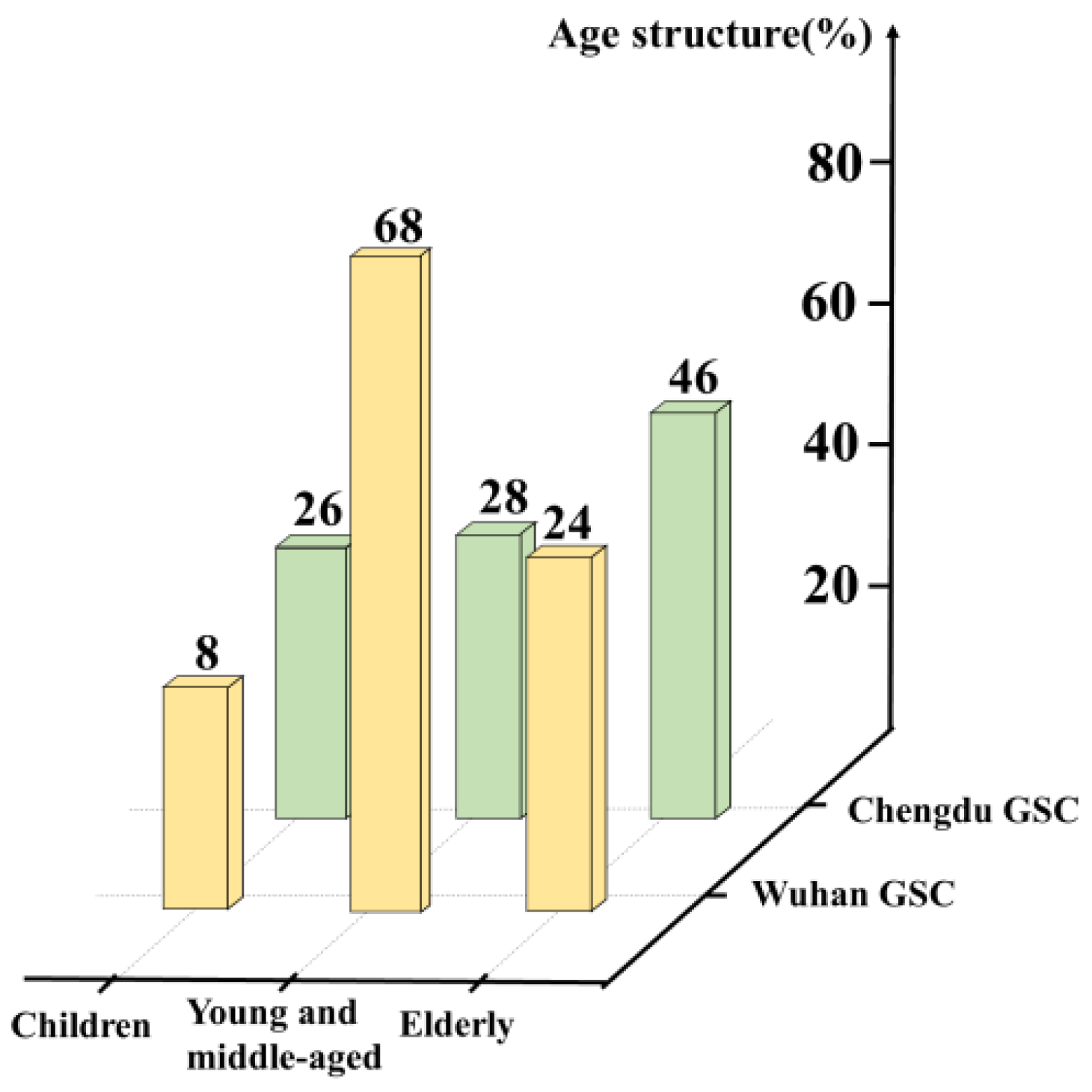
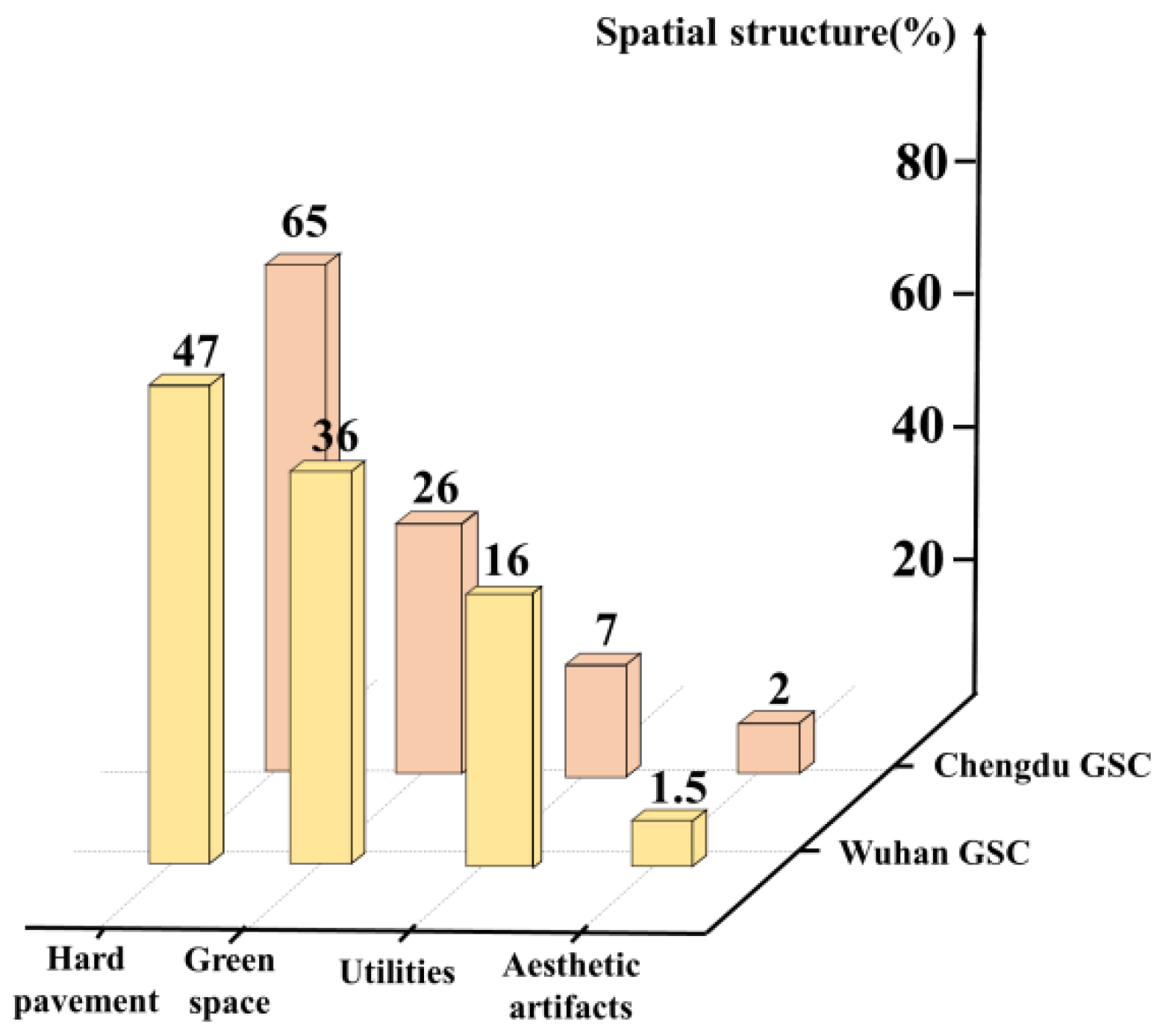
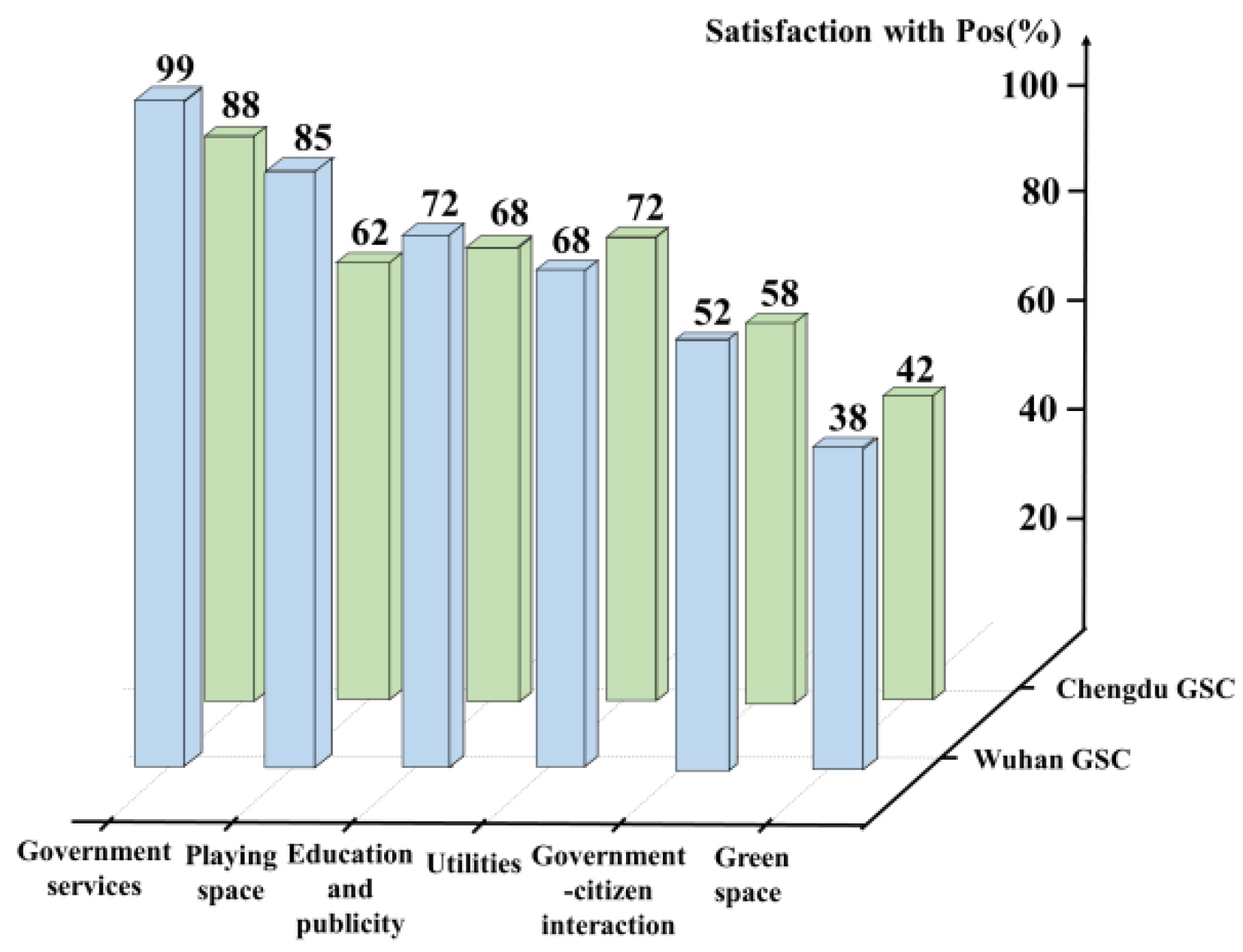

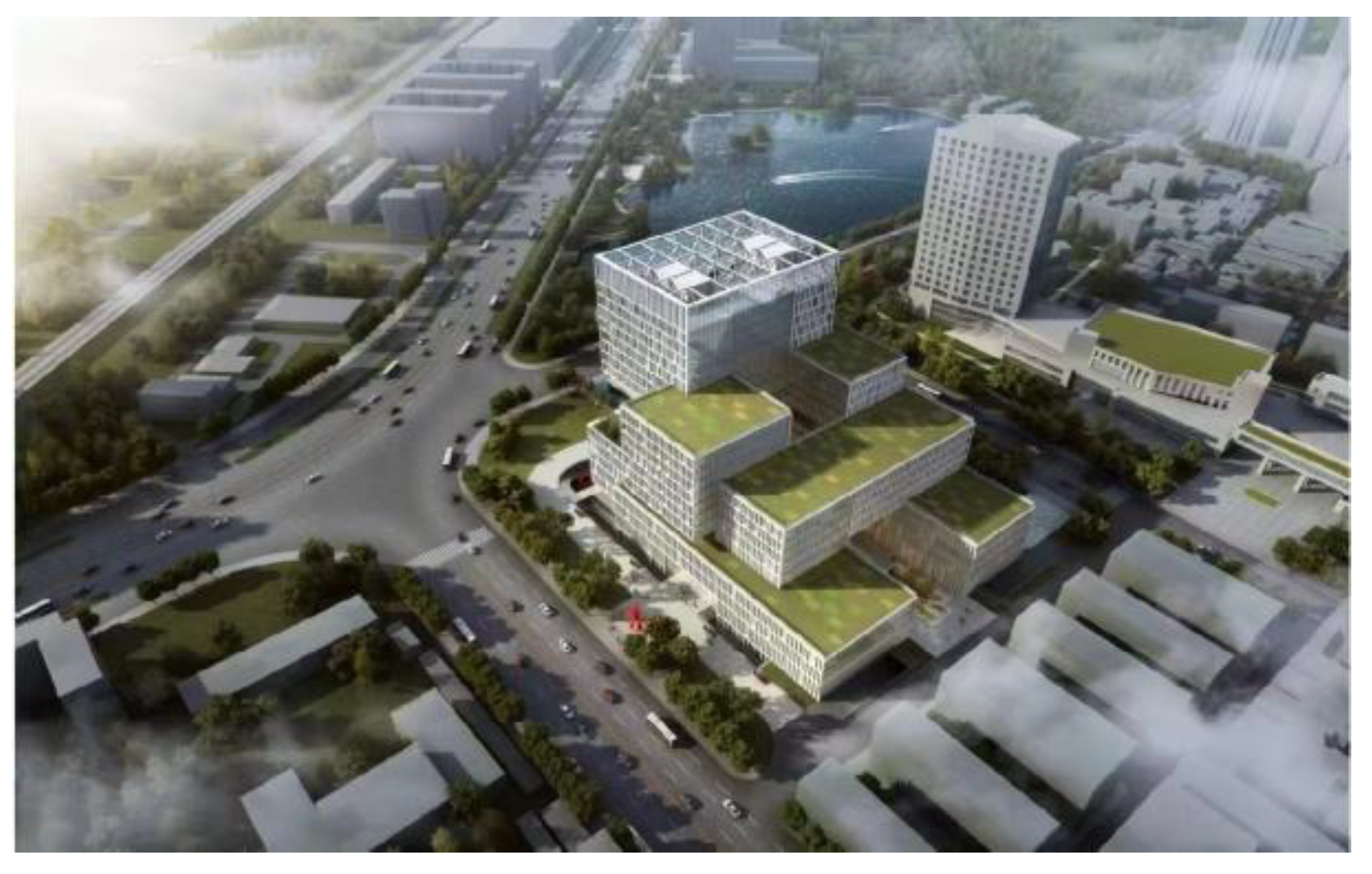





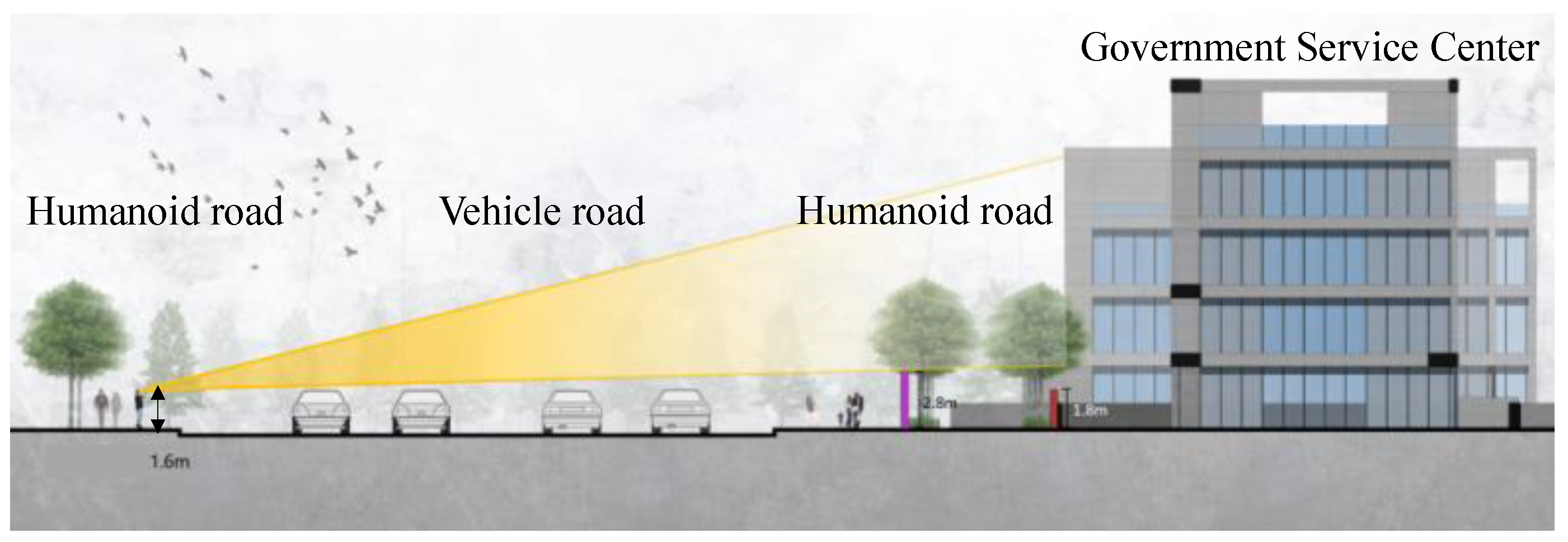
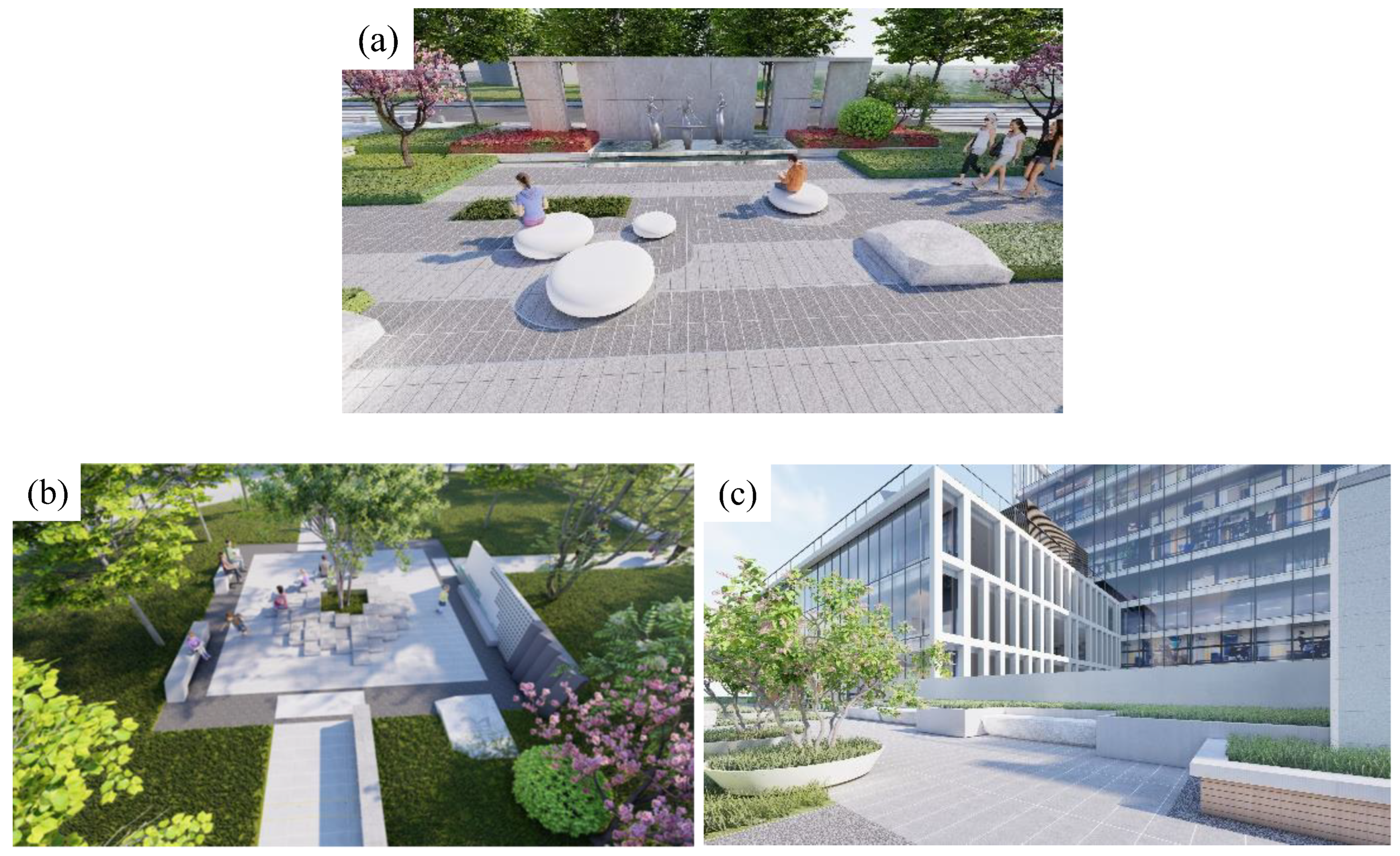
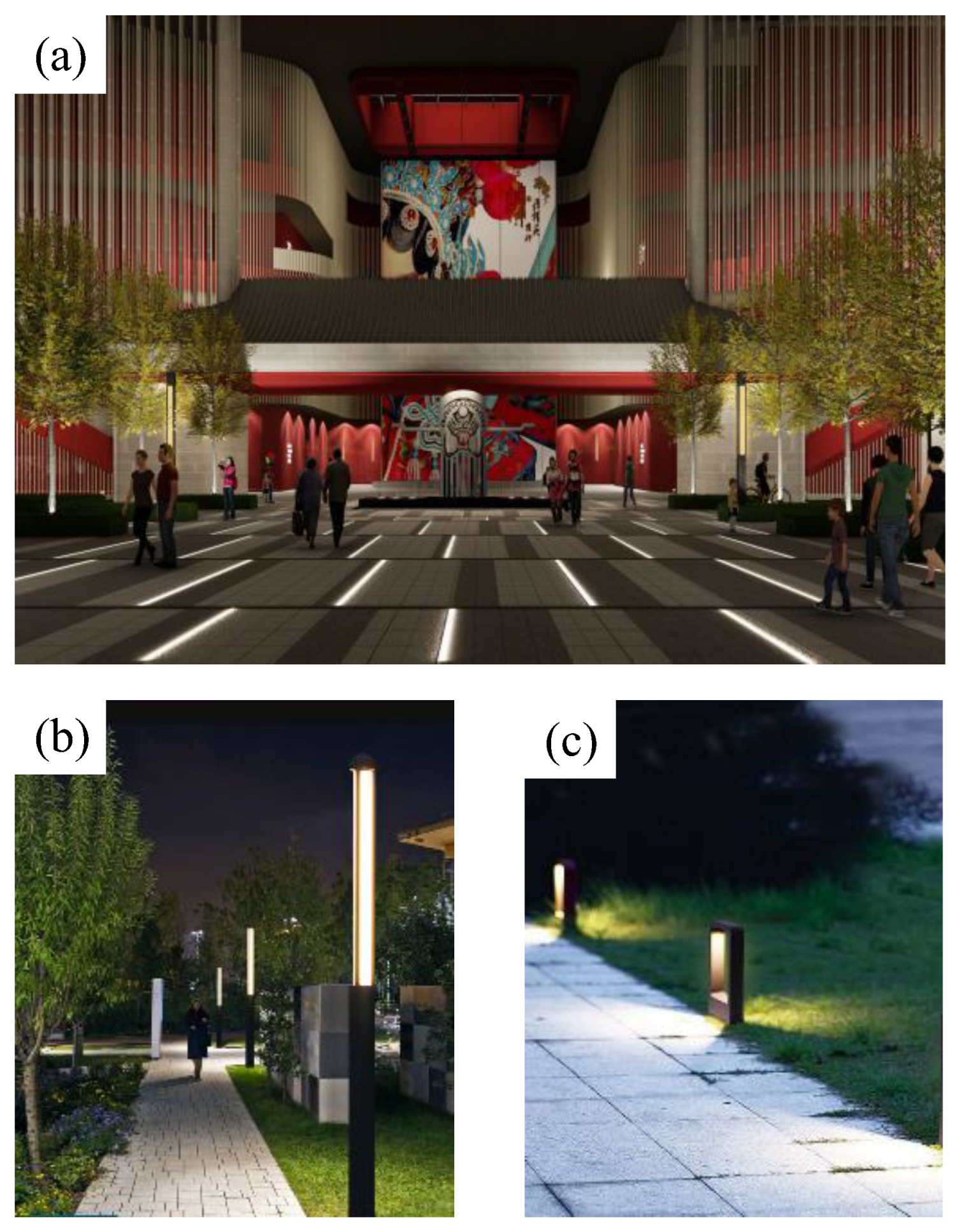
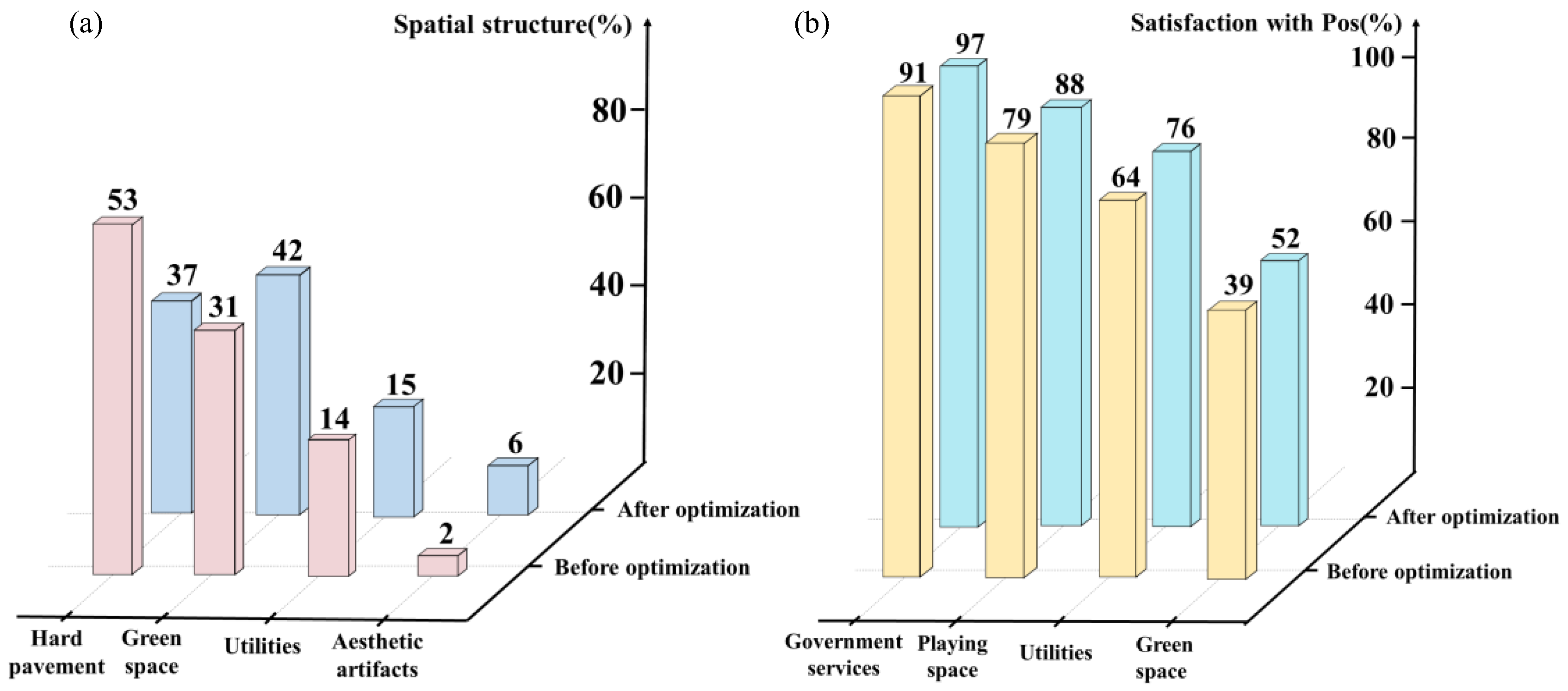
| Basic Form | Example Image | Health Characteristics |
|---|---|---|
| Symmetrical | 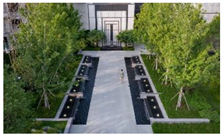 | Emphasizing symmetry, order, and balance, the design features a prominent central axis framed by a symmetrical arrangement [33]. Plants are meticulously organized in evenly spaced rows or recurring patterns. |
| Open | 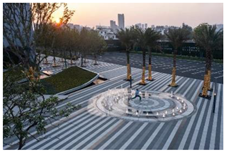 | Offers an expansive, inclusive, and unobstructed vista to facilitate social interactions and various activities. Vegetation occupies a minimal portion of the area, primarily serving decorative and shading purposes, while seamlessly integrating with the natural surroundings or existing landscape. |
| Semi-open | 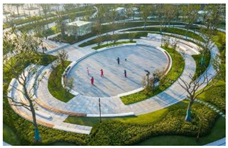 | Creates balance between openness and seclusion; akin to the open layout but with reduced openness; incorporates high plants to enclose one or more sides, creating a more private ambiance with limited visibility. |
Disclaimer/Publisher’s Note: The statements, opinions and data contained in all publications are solely those of the individual author(s) and contributor(s) and not of MDPI and/or the editor(s). MDPI and/or the editor(s) disclaim responsibility for any injury to people or property resulting from any ideas, methods, instructions or products referred to in the content. |
© 2024 by the authors. Licensee MDPI, Basel, Switzerland. This article is an open access article distributed under the terms and conditions of the Creative Commons Attribution (CC BY) license (https://creativecommons.org/licenses/by/4.0/).
Share and Cite
Wang, Y.; Peng, W.; Huang, Y.; Yang, T.; Du, X.; Wang, X.; Zhang, Z.; Zhu, L. Research on the Design Strategies of Public Outdoor Spaces in Government Centers from a Health Perspective. Buildings 2024, 14, 1505. https://doi.org/10.3390/buildings14061505
Wang Y, Peng W, Huang Y, Yang T, Du X, Wang X, Zhang Z, Zhu L. Research on the Design Strategies of Public Outdoor Spaces in Government Centers from a Health Perspective. Buildings. 2024; 14(6):1505. https://doi.org/10.3390/buildings14061505
Chicago/Turabian StyleWang, Yilin, Wenjun Peng, Yanyan Huang, Tiancheng Yang, Xinyu Du, Xinyan Wang, Zhengming Zhang, and Liang Zhu. 2024. "Research on the Design Strategies of Public Outdoor Spaces in Government Centers from a Health Perspective" Buildings 14, no. 6: 1505. https://doi.org/10.3390/buildings14061505
APA StyleWang, Y., Peng, W., Huang, Y., Yang, T., Du, X., Wang, X., Zhang, Z., & Zhu, L. (2024). Research on the Design Strategies of Public Outdoor Spaces in Government Centers from a Health Perspective. Buildings, 14(6), 1505. https://doi.org/10.3390/buildings14061505





